key OLDSMOBILE CUTLASS 1997 Owner's Manual
[x] Cancel search | Manufacturer: OLDSMOBILE, Model Year: 1997, Model line: CUTLASS, Model: OLDSMOBILE CUTLASS 1997Pages: 353, PDF Size: 16.72 MB
Page 148 of 353
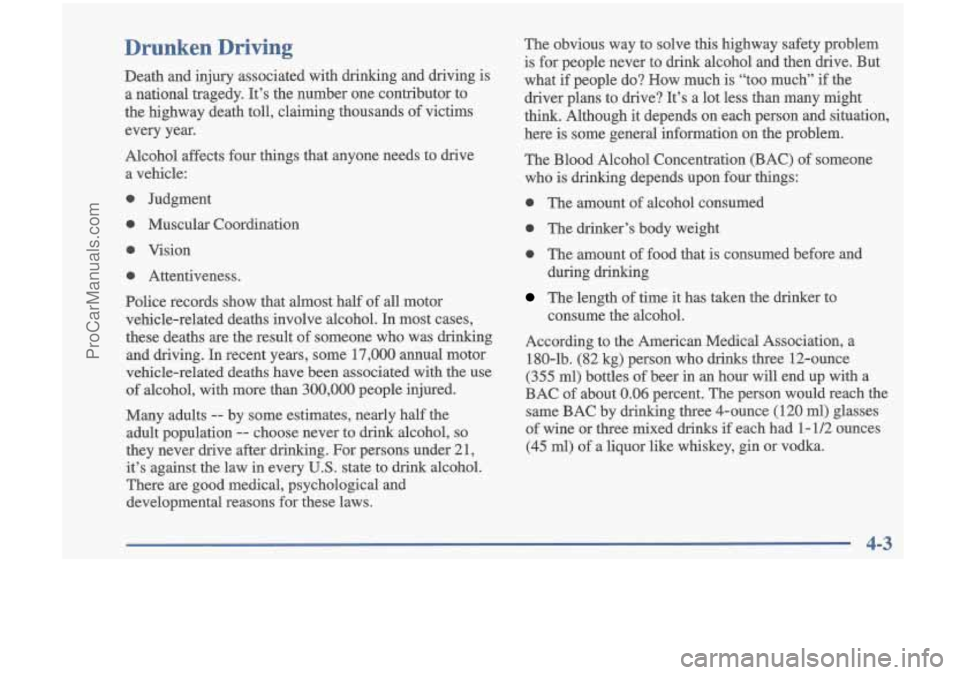
Drunken Driving
Death and injury associated with drinking and driving is
a national tragedy. It’s the number one contributor to
the highway death toll, claiming thousands of victims
every year.
Alcohol affects four things that anyone needs to drive
a vehicle:
0 Judgment
0 Muscular Coordination
0 Vision
0 Attentiveness.
Police records show that almost half of all motor
vehicle-related deaths involve alcohol. In most cases,
these deaths
are the result of someone who was drinking
and driving. In recent years, some 17,000 annual motor
vehicle-related deaths have been associated with the use
of alcohol, with more than
300,000 people injured.
-Many adults
-- by some estimates, nearly half the
adult population
-- choose never to drink alcohol, so
they never drive after drinking. For persons under 2 1,
it’s against the law in every U.S. state to drink alcohol.
There are good medical, psychological and
developmental reasons for these laws. The
obvious way to solve this highway safety problem
is for people never to drink alcohol and then drive. But
what
if people do? How much is “too much” if the
driver plans to drive? It’s a lot less than many might
think. Although it depends on each person and situation,
here is some general information on the problem.
The Blood Alcohol Concentration (BAC) of someone
who is drinking depends upon four things:
0 The amount of alcohol consumed
0 The drinker’s body weight
0 The amount of food that is consumed before and
during drinking
The length of time it has taken the drinker to
According to the American Medical Association, a 180-lb. (82 kg) person who drinks three 12-ounce
(355 ml) bottles of beer in an hour will end up with a
BAC
of about 0.06 percent. The person would reach the
same BAC by drinking three 4-ounce (120
ml) glasses
of wine or three mixed drinks
if each had 1- 1/2 ounces
(45
ml) of a liquor like whiskey, gin or vodka
consume the alcohol.
4-3
ProCarManuals.com
Page 173 of 353
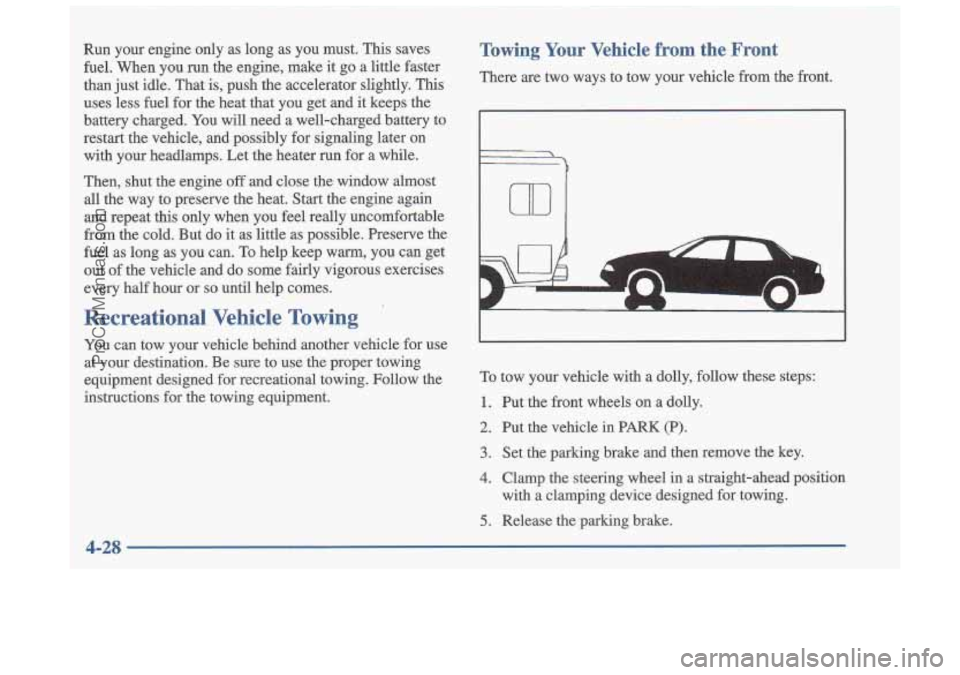
Run your engine only as long as you must. This saves fuel. When you run the engine, make it go a little faster
than just idle. That is, push the accelerator slightly. Ths
uses less fuel for the heat that you get and it keeps the
battery charged. You will need a well-charged battery to
restart the vehicle, and possibly for signaling later on
with your headlamps. Let the heater run for a while.
Then, shut the engine
off and close the window almost
all the way to preserve the heat. Start the engine again
and repeat this only when you feel really uncomfortable
from the cold. But do it as little as possible. Preserve the
fuel as long as you can. To help keep warm, you can get
out of the vehicle and do some fairly vigorous exercises
every half hour or
so until help comes.
Recreational Vehicle Towing
You can tow your vehicle behind another vehicle for use
at your destination. Be sure to use the proper towing
equipment designed for recreational towing. Follow the
instructions for the towing equipment.
Towing Your Vehicle from the Front
There are two ways to tow your vehicle from the front.
€
m
To tow your vehicle with a dolly, follow these steps:
1. Put the front wheels on a dolly.
2. Put the vehicle in PARK (P).
3. Set the parking brake and then remove the key.
4. Clamp the steering wheel in a straight-ahead position
with a clamping device designed for towing.
5. Release the parking brake.
ProCarManuals.com
Page 174 of 353
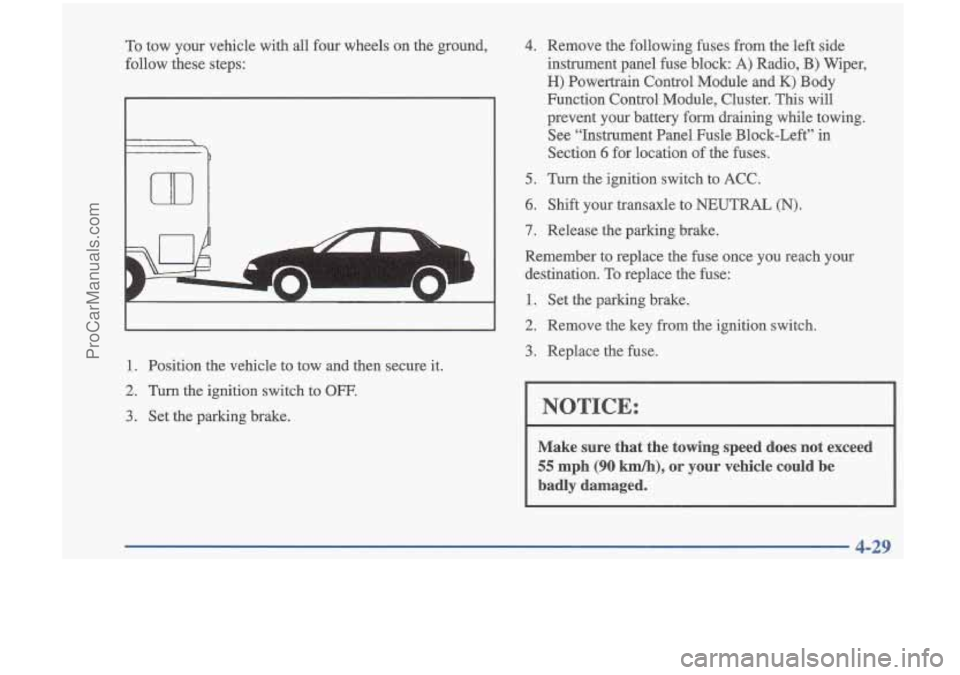
To tow your vehicle with all four wheels on the ground,
follow these steps:
7 ---
1. Position the vehicle to tow and then secure it.
2. Turn the ignition switch to OFF.
3. Set the parking brake.
4. Remove the following fuses from the left side
instrument panel fuse block:
A) Radio, B) Wiper,
H) Powertrain Control Module and K) Body
Function Control Module, Cluster. This will
prevent your battery
form draining while towing.
See “Instrument Panel Fusle Block-Left” in
Section
6 for location of the fuses.
5. Turn the ignition switch to ACC.
6. Shift your transaxle to NEUTRAL (N).
7. Release the parking brake.
Remember
to replace the fuse once you reach your
destination. To replace the fuse:
1. Set the parking brake.
2. Remove the key from the ignition switch.
3. Replace the fuse.
I NOTICE:
Make sure that the towing speed does not exceed
55 mph (90 km/h), or your vehicle could be
badly damaged.
4-29
ProCarManuals.com
Page 189 of 353
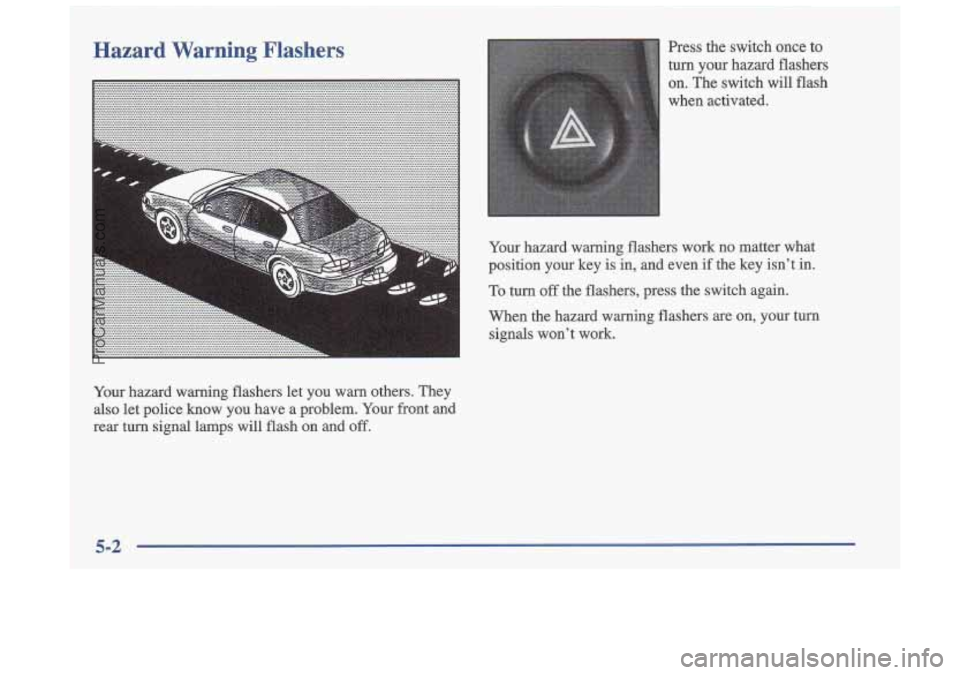
Hazard Warning Flashers
Your hazard warning flashers let you warn others. They
also let police know you have a problem. Your front and
rear turn signal lamps will flash on and
off.
Press the switch once to
turn your hazard flashers
on. The switch will flash
when activated.
Your hazard warning flashers work no matter what
position your key is in, and even
if the key isn’t in.
To turn
off the flashers, press the switch again.
When the hazard warning flashers are on, your turn signals won’t work.
ProCarManuals.com
Page 321 of 353
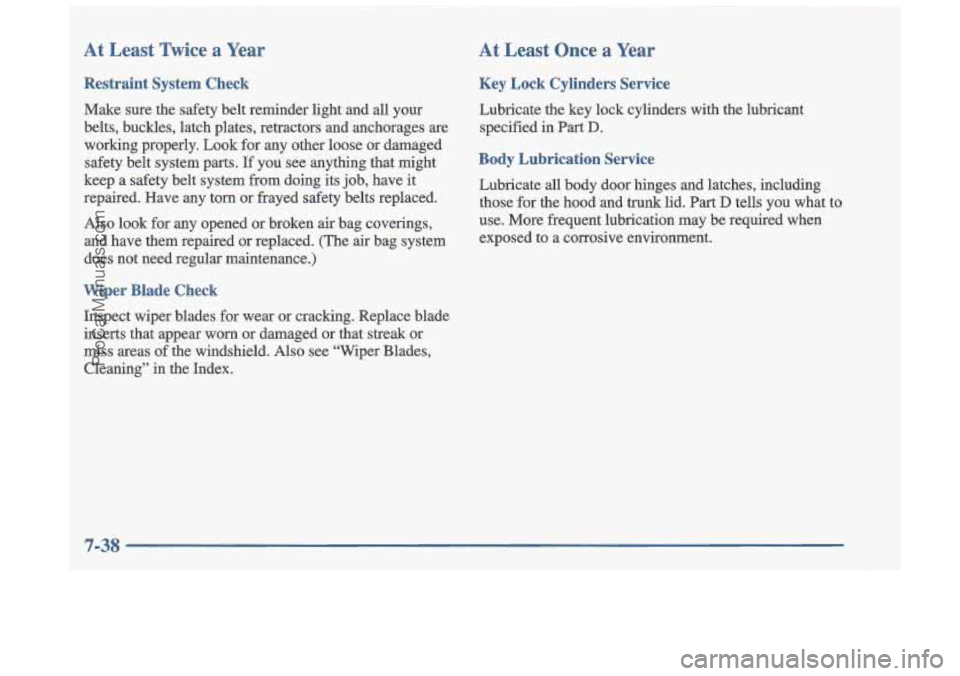
At Least Twice a Year
Restraint System Check
Make sure the safety belt reminder light and all your
belts, buckles, latch plates, retractors and anchorages
are
working properly. Look for any other loose or damaged
safety belt system parts. If you see anything that might
keep a safety belt system fkom doing its job, have it
repaired. Have any torn or €rayed safety belts replaced.
Also look for any opened or broken air bag coverings,
and have them repaired
or replaced. (The air bag system
does not need regular maintenance.)
Wiper Blade Check
Inspect wiper blades for wear or cracking. Replace blade
inserts that appear
worn or damaged or that streak or
miss areas of the windshield. Also see “Wiper Blades,
Cleaning” in the Index.
At Least Once a Year
Key Lock Cylinders Service
Lubricate-the key lock cylinders with the lubricant
specified
in Part D.
Body Lubrication Service
Lubricate all body door hinges and latches, including those for the hood and trunk lid.
Part D tells you what to
use. More frequent lubrication may be required when exposed to a corrosive environment.
ProCarManuals.com
Page 322 of 353
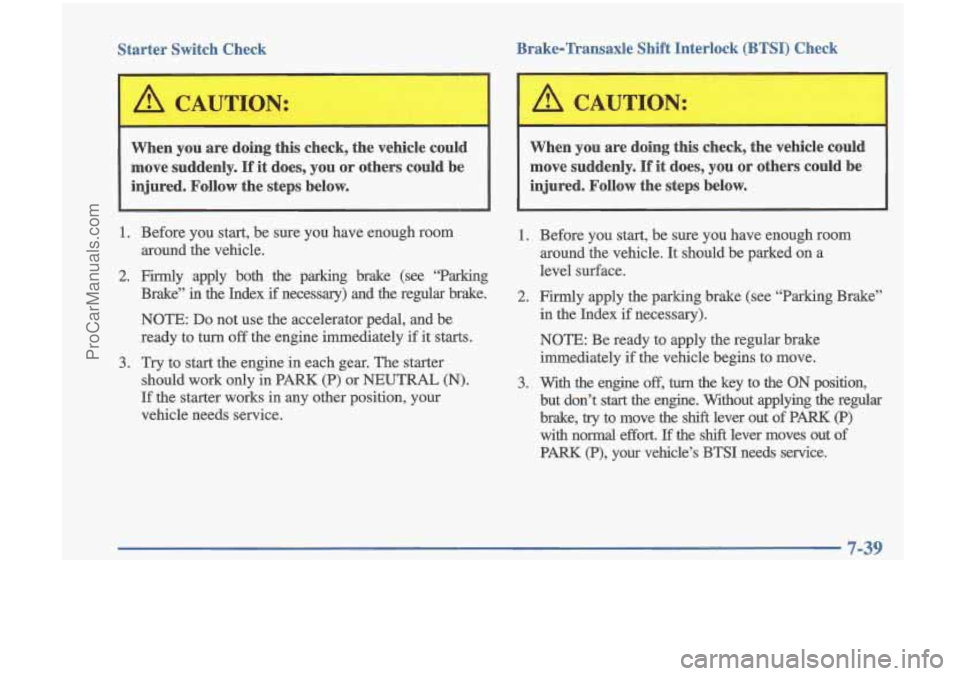
Starter Switch Check Brake-Transaxle Shift Interlock (BTSI) Check
When you are doing
this check, the vehicle could
move suddenly.
If it does, you or others could be
injured. Follow the steps below.
c I
When you are doing this check, the vehicle could
move suddenly.
If it does, you or others could be
injured. Follow the steps below.
1. Before you start, be sure you have enough room
2. Firrnly apply both the parking brake (see “Parking
Brake”
in the Index if necessary) and the regular brake.
NOTE:
Do not use the accelerator pedal, and be
ready to turn
off the engine immediately if it starts.
3.
Try to start the engine in each gear. The starter
should work only in PARK (P) or
NEUTRAL (N).
If the starter works in any other position, your
vehicle needs service. around
the vehicle.
1. Before you start, be sure you have enough room
around the vehicle. It should be parked on a
level surface.
2. Firrnly apply the parking brake (see “Parking Brake”
in the Index if necessary).
NOTE: Be ready to apply the regular brake
immediately if the vehicle begins to move.
3. With the engine off, turn the key to the ON position,
but don’t
start the engine. Without applying the regular
brake,
‘uy to move the shift lever out of PARK (P)
with normal effort. If the shift lever moves out of
PARK (P), your vehicle’s BTSI needs service.
7-39
ProCarManuals.com
Page 323 of 353
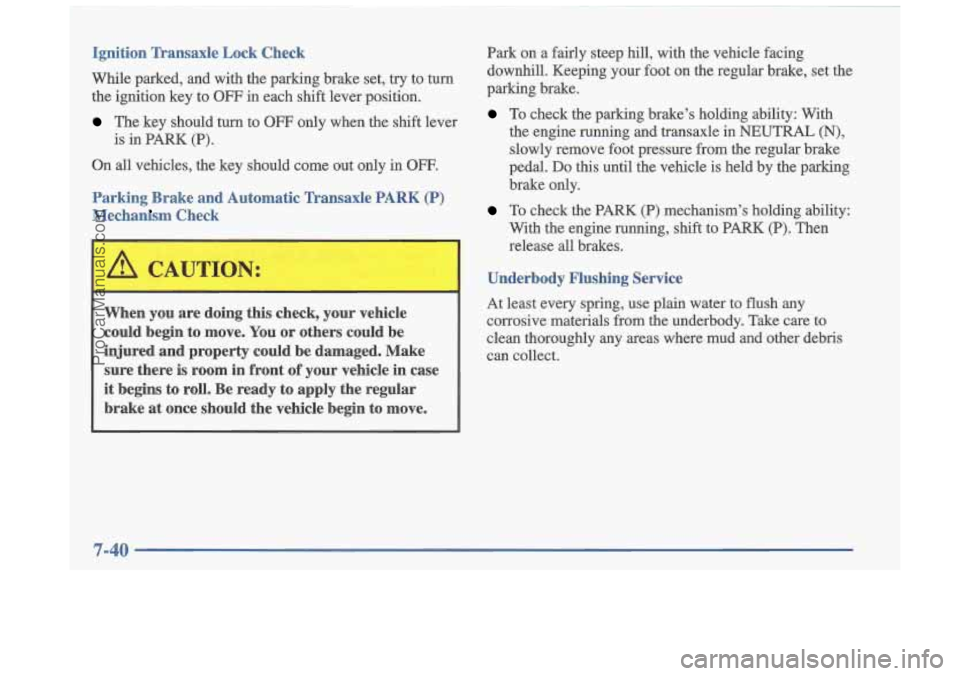
Ignition Transaxle Lock Check
While parked, and with the parking brake set, try to turn the ignition key
to OFF in each shift lever position.
The key should turn to OFF only when the shift lever
On all vehicles, the key should come out only in
OFF.
is in PARK (P).
Parking Brake and Automatic Transaxle PARK
(P)
MecT m .-,’ leck
When you are doing this check, your vehicle
could begin to move. You
or others could be
injured and property could be damaged. Make
sure there
is room in front of your vehicle in case
it begins to roll. Be ready to apply the regular
brake
at once should the vehicle begin to move. Park on
a fairly steep hill, with the vehicle facing
downhill. Keeping your foot on the regular brake, set the
parking brake.
To check the parking brake’s holding ability: With
the engine running and transaxle in
NEUTRAL (N),
slowly remove foot pressure from the regular brake
pedal.
Do this until the vehicle is held by the parking
brake only.
To check the PARK (P) mechanism’s holding ability:
With the engine running, shift to PARK
(P). Then
release all brakes.
Underbody Flushing Service
At least every spring, use plain water to flush any corrosive materials from the underbody. Take care to
clean thoroughly any areas where mud and other debris
can collect.
7-40
ProCarManuals.com
Page 325 of 353
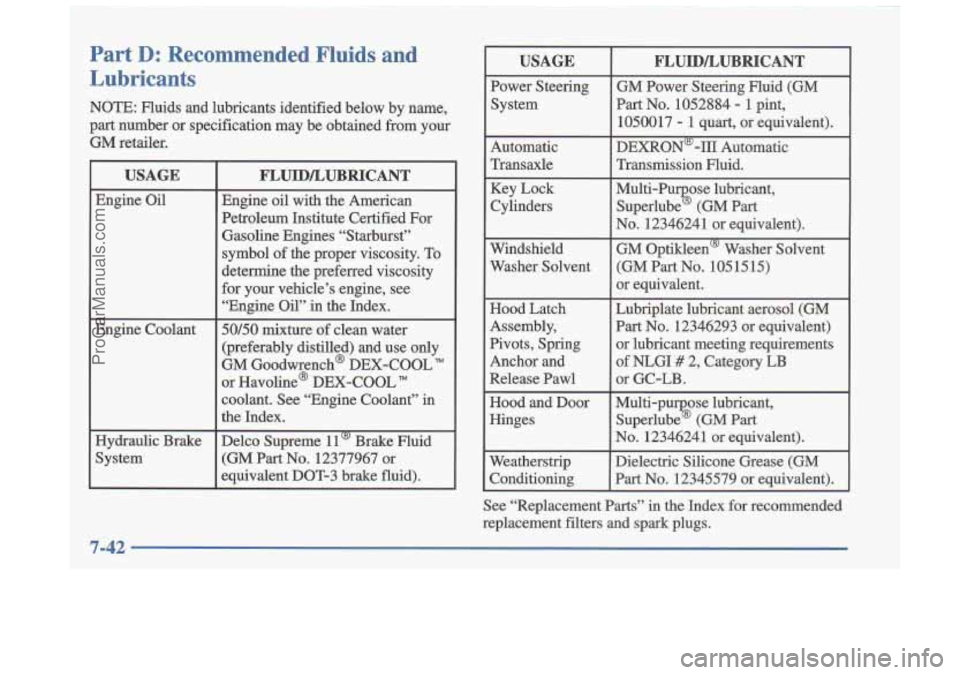
Part D: Recommended Fluids and
Lubricants
NOTE: Fluids and lubricants identified below by name,
part number
or specification may be obtained from your
GM retailer.
USAGE
Engine Oil
Engine Coolant
Hydraulic Brake
System
FLUIDLUBRICANT
Engine oil with the American
Petroleum Institute Certified For Gasoline Engines “Starburst”
symbol of the proper viscosity. To
determine the preferred viscosity
for your vehicle’s engine, see
“Engine
Oil“ in the Index, ~
50/50 mixture of clean water
(preferably distilled) and use only
GM Goodwrench@ DEX-COOL
Rul
or Havoline@ DEX-COOL TM
coolant. See “Engine Coolant” in
the Index.
Delco Supreme
11@ Brake Fluid
(GM Part
No. 12377967 or
equivalent DOT-3 brake fluid).
~~
USAGE
Power Steering
System
Automatic
Transaxle Key Lock
Cylinders
Windshield
Washer Solvent
Hood Latch
Assembly,
Pivots, Spring
Anchor and
Release Pawl
Hood and Door
Hinges
Weatherstrip Conditioning
FLUIDLUBRICANT
GM Power Steering Fluid (GM
Part No. 1052884 - 1 pint,
1050017
- 1 quart, or equivalent).
DEXRON@-III Automatic
Transmission Fluid.
Multi-Pu ose lubricant, Superlube
% (GM Part
No. 12346241 or equivalent).
GM Optikleen@) Washer Solvent (GM
Part No. 1051515)
or equivalent.
Lubriplate lubricant aerosol (GM
Part No. 12346293 or equivalent) or lubricant meeting requirements
of NLGI
# 2, Category LB
or GC-LB.
Multi-pu ose lubricant, Superlube
% (GM Part
No. 12346241 or equivalent).
Dielectric Silicone Grease (GM
Part No. 12345579 or equivalent).
See “Replacement
Parts” in the Index for recommended
replacement filters and spark plugs.
7-42
ProCarManuals.com
Page 346 of 353
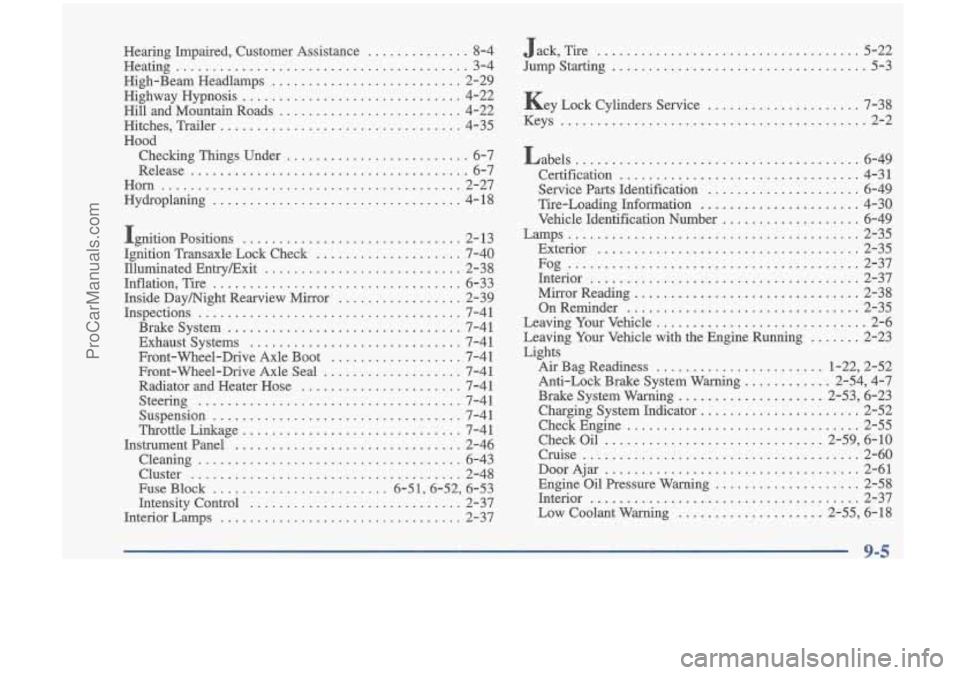
Hearing Impaired. Customer Assistance .............. 8-4
High-Beam Headlamps
.......................... 2-29
Highway Hypnosis
.............................. 4-22
Hill and Mountain Roads
......................... 4-22
Hitches. Trailer
................................. 4-35
Hood
Checking Things Under
......................... 6-7
Release
...................................... 6-7
Horn
......................................... 2-27
Hydroplaning
.................................. 4-18
Ignition Positions
.............................. 2- 13
Ignition Transaxle Lock Check
.................... 7-40
IlluminatedEntryExit
........................... 2-38
Inflation. Tire
.................................. 6-33
Inside Daymight Rearview Mirror
................. 2-39
Inspections
.................................... 7-41
Brake System
................................ 7-41
Exhaust Systems
............................. 7-41
Front-Wheel-Drive Axle Boot
.................. 7-41
Front-Wheel-Drive Axle Seal
................... 7-41
Radiator and Heater Hose
...................... 7-41
Steering
.................................... 7-41
Suspension
.................................. 7-41
Throttle Linkage
.............................. 7-41
Instrument Panel
............................... 2-46
Cleaning
.................................... 6-43
Cluster
............................ .. ........ 2-48
Fuse Block
........................ 6.51.6.52. 6.53
Intensity Control
............................. 2-37
Interior Lamps
................................. 2-37
Heating
........................................ 3-4
Jack. Tire
.................................... 5-22
Jump Starting
................................... 5-3
Key Lock Cylinders Service
..................... 7-38
Keys
.......................................... 2-2
Labels
....................................... 6-49
Certification
................................. 4-31
Service Parts Identification
..................... 6-49
Tire-Loading Information
...................... 4-30
Vehicle Identification Number
.................... 6-49
Lamps
........................................ 2-35
Exterior
.................................... 2-35
Fog
........................................ 2-37
Interior
..................................... 2-37
MirrorReading
............................... 2-38
OnReminder
................................ 2-35
Leaving
Your Vehicle ............................. 2-6
Leaving
Your Vehicle with the Engine Running ....... 2-23
Lights
Air Bag Readiness ....................... 1-22. 2-52
Anti-Lock Brake System Warning
............ 2.54. 4.7
Brake System Warning
.................... 2.53. 6.23
CheckEngine
................................ 2-55
CheckOil
.............................. 2.59. 6.10
Cruise
...................................... 2-60
DoorAjar
................................... 2-61
Engine Oil Pressure Warning
.................... 2-58
Interior ..................................... 2-37
Low Coolant Warning
.................... 2.55. 6.18
Charging System Indicator
...................... 2-52
ProCarManuals.com
Page 347 of 353
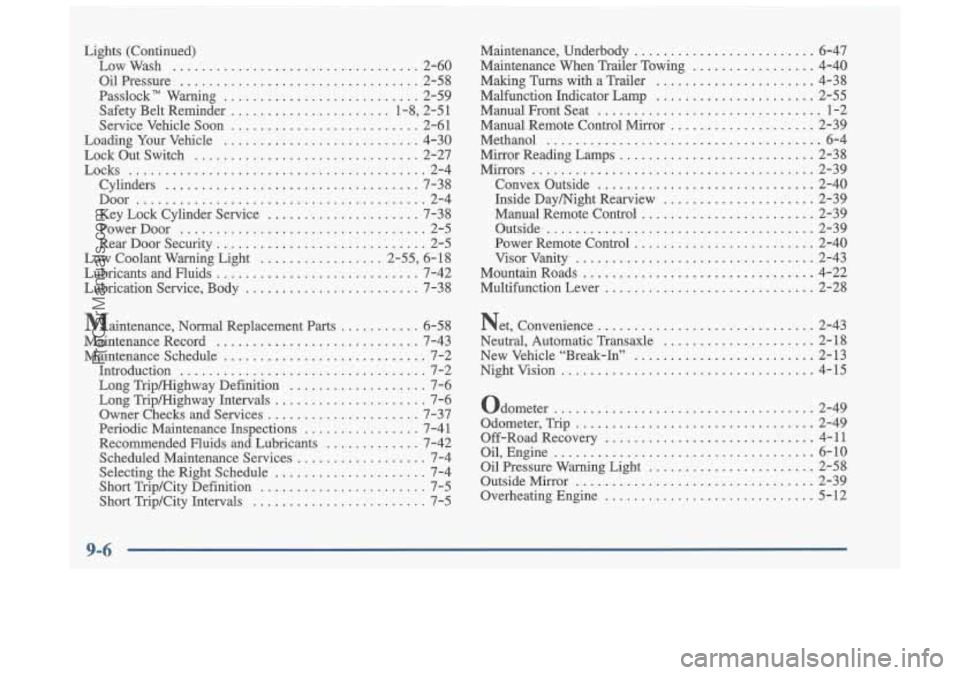
Lights (Continued) Low Wash
.................................. 2-60
Oil Pressure
................................. 2-58
Passlock Warning
........................... 2-59
Safety Belt Reminder
...................... 1.8. 2.5 1
Service Vehicle Soon
.......................... 2-61
Loading
Your Vehicle ........................... 4-30
Lock Out Switch
............................... 2-27
Locks
......................................... 2-4
Cylinders
................................... 7-38
Door
........................................ 2-4
Key Lock Cylinder Service
..................... 7-38
Power Door
.................................. 2-5
Low Coolant Warning Light
................. 2-55, 6- 18
Lubricants and Fluids ............................ 7-42
Lubrication Service, Body
........................ 7-38
Maintenance, Normal Replacement
Parts ........... 6-58
Maintenance Record
............................ 7-43
Maintenance Schedule
............................ 7-2
Introduction
.................................. 7-2
Long Tripmighway Definition
................... 7-6
Long Tripmighway Intervals
..................... 7-6
Owner Checks and Services
..................... 7-37
Periodic Maintenance Inspections
................ 7 -4 1
Recommended Fluids and Lubricants ............. 7-42
Scheduled Maintenance Services
.................. 7-4
Selecting the Right Schedule
..................... 7-4
Short Trip/City Definition
....................... 7-5
Short Trip/City Intervals
........................ 7-5
RearDoorSecu
rity
............................. 2-5 Maintenance. Underbody
......................... 6-47
Maintenance When Trailer Towing
................. 4-40
Making
Turns with a Trailer ...................... 4-38
ManualFrontSeat
............................... 1-2
Manual Remote Control Mirror
.................... 2-39
Methanol
...................................... 6-4
Mirror Reading Lamps ........................... 2-38
Mirrors
....................................... 2-39
Convex Outside
.............................. 2-40
Inside Daymight Rearview
..................... 2-39
Manual Remote Control
........................ 2-39
Outside
..................................... 2-39
Power Remote Control
......................... 2-40
Visor Vanity
................................. 2-43
MountainRoads
................................ 4-22
Multifunction Lever
............................. 2-28
Net, Convenience
.............................. 2-43
Neutral, Automatic Transaxle
..................... 2-18
New Vehicle “Break-In”
......................... 2-13
Nightvision
................................... 4-15
Odometer
.................................... 2-49
Odometer, Trip
................................. 2-49
Oil, Engine
.................................... 6-10
Outside Mirror
................................. 2-39
Overheating Engine
............................. 5-12
Malfunction Indicator Lamp
...................... 2-55
Off-Road Recovery
............................. 4-11
Oil Pressure Warning Light
....................... 2-58
9-6
ProCarManuals.com